Newly Launched - AI Presentation Maker

AI PPT Maker
Powerpoint Templates
Icon Bundle
Kpi Dashboard
Professional
Business Plans
Swot Analysis
Gantt Chart
Business Proposal
Marketing Plan
Project Management
Business Case
Business Model
Cyber Security
Business PPT
Digital Marketing
Digital Transformation
Human Resources
Product Management
Artificial Intelligence
Company Profile
Acknowledgement PPT
PPT Presentation
Reports Brochures
One Page Pitch
Interview PPT
All Categories


Anti Money Laundering and Compliance Program Training Ppt
The PPT Training Module on Anti Money Laundering and Compliance Program offers a comprehensive overview of Customer Due Diligence CDD and related compliance practices in the context of Anti Money Laundering AML. It starts by explaining the concept Know Your Customer and Customer Due Diligence CDD, and then compares Enhanced Due Diligence EDD vs Simplified Due Diligence, highlighting their differences and applications. The PowerPoint Deck then explores What is Ongoing Monitoring. It discusses the basis of CDD, detailing when and how it should be conducted. It also addresses handling Politically Exposed Persons and the procedure for filing a Suspicious Activity Report SAR, including a step by step guide on the process. A Sample Customer Due Diligence Flowchart and CDD Decision Flow are included for visual representation of the CDD process. Best practices, benefits, and challenges of CDD and EDD are thoroughly discussed, offering a balanced perspective. The PowerPoint Presentation also includes CDD Checklists for various account types. Additionally, it covers Designated Non Financial Businesses and Professions DNFBPs, outlining the industries included and their FATF requirements. Finally, it provides practical tools like an AML Policy Template and an AML Questionnaire, making this PowerPoint a vital resource for organizations aiming to enhance their AML and compliance programs. The Presentation also has Key Takeaways and Discussion Questions related to the topic to make the training session more interactive.
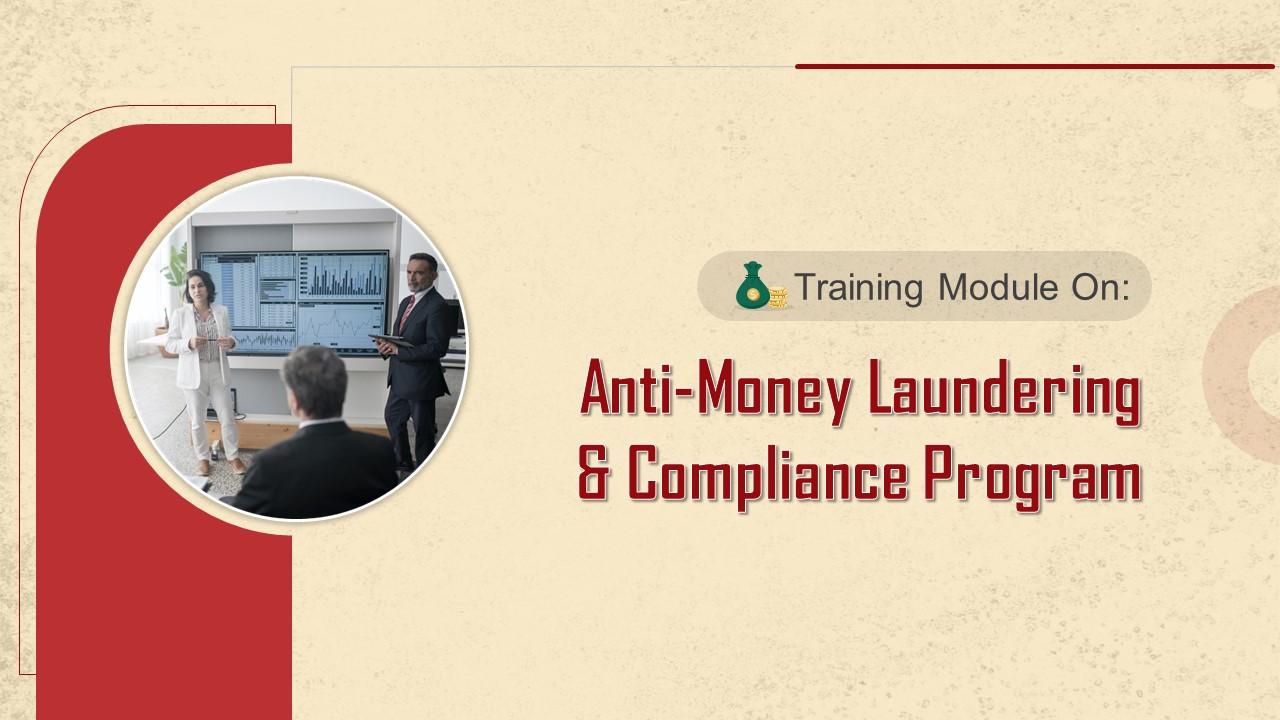
- Add a user to your subscription for free
You must be logged in to download this presentation.
PowerPoint presentation slides
Presenting Training Deck on Anti Money Laundering and Compliance Program. This deck comprises of 38 slides. Each slide is well crafted and designed by our PowerPoint experts. This PPT presentation is thoroughly researched by the experts, and every slide consists of appropriate content. All slides are customizable. You can add or delete the content as per your need. Not just this, you can also make the required changes in the charts and graphs. Download this professionally designed business presentation, add your content, and present it with confidence.

People who downloaded this PowerPoint presentation also viewed the following :
- Business Slides , Complete Decks , All Decks , Financial Analysis , Finance and Accounting , Training Modules , All Modules , Artificial Intelligence
- Money Laundering Prevention ,
- Financial Crime Mitigation ,
Content of this Powerpoint Presentation
This slide introduces the concept of Know Your Customer and Customer Due Diligence. CDD is the process of collecting & identifying information to verify or confirm a customer’s identity and accurately determine the level of criminal risk they present.
This slide discusses the importance of Know Your Customer and Customer Due Diligence. CDD is vital for organizations for a variety of reasons such as protection against financial crimes, identification of unusual customer behavior, etc.
This slide highlights the difference between Simplified Due Diligence and Enhanced Due Diligence. Simplified Due Diligence is a less rigorous version of standard due diligence whereas Enhanced Due Diligence is implemented for high-risk clients such as Politically Exposed Persons (PEPs).
This slide talks about the concept of Ongoing Monitoring. Ongoing monitoring refers to the continuous examination of business relationships. This approach is essential because, while occasional transactions may not seem suspicious at first, they may indicate a pattern of behavior over an extended period.
This slide talks about the concept of Ongoing Monitoring. Ongoing monitoring involves ensuring a customer’s risk profile matches their behavior, keeping relevant records, and responding quickly to any changes in a customer’s risk profile.
This slide discusses what CDD is based on. CDD is based on three basic regulatory obligations: Customer identification, beneficial ownership, and business relationship.
Instructor’s Notes:
- Customer Identification: Companies are required to identify their clients by gathering personal information and data, such as name, government ID, address, and birth certificate, from a reliable and independent source
- Beneficial Ownership: Companies should try to identify Ultimate Beneficial Ownership (UBO) when a business or third party is working on the behalf of someone else. The idea is to have a record of individual(s) who benefit from the actions of a person or a group of people
- Business Relationship: Companies must identify the nature and purpose of the business relationship they are forming with the client in addition to identifying the customer and the beneficial ownership of the entity
This slide depicts when customer due diligence is required. CDD is required under the following circumstances: New business relationships, occasional transactions, money laundering suspicion, ongoing monitoring, and unreliable documentation.
- New Business Relationships: Information collected on new customers will help make sure they are not using a false identity to access services
- Occasional Transactions: CDD procedures are necessary if a transaction exceeds regulatory criteria or involves firms in high-risk foreign nations
- Money Laundering Suspicion: Companies should undertake further CDD checks if a customer is suspected of financing terrorism or money laundering
- Ongoing Monitoring: Companies should carry out CDD throughout the entirety of a business relationship to make sure that transactions match the established risk profiles of their clients
- Unreliable Documentation: Organizations should conduct stricter CDD to resolve discrepancies when customers provide insufficient identification documents
This slide depicts the step-by-step process of conducting customer due diligence. The steps are: Identification, verification, nature of relationship, additional information, documentation, and AML risk scoring.
- Identification: The first step is identifying the customer. This can be as basic as identifying their first and last name
- Verification: The next step is verification. This can include verifying your client’s government ID card or passport. The verification of a client’s or beneficial owner’s identity is critically important
- Nature of Relationship: The next thing you should establish as part of your CDD program is the goal and intended nature of the business relation
- Additional Information: The information you gather from the customer may also include their location, their occupation, the types of business transactions they want to do with you, payment methods, their geographical area, and the industry they operate in, etc
- Documentation: It is essential to document all information collected from the customers, preferably on an IT system
- AML Risk Scoring: The last step entails determining the money laundering or terrorist financing risk a customer poses to your organization. You can determine a client’s risk score based on a three-tier scale: low, moderate, high
This slide tells us how to deal with politically exposed persons or PEPs. A PEP is an individual that has been in-charge of a prominent public role or political function.
- Identifying PEPs: Numerous databases list people with current or previous political roles or other prominent functions. These databases can be used to identify PEPs. PEPs can also include immediate family members
- Obtaining senior management approval: Since PEPs pose a potentially high risk of money laundering, senior management approval is required to establish or continue a business relationship
- Establishing source of funds: It is essential to determine the source of funds of PEPs to ensure no involvement in money laundering or terrorist financing
- Applying ongoing EDD: Finally, enhanced due diligence and ongoing monitoring are applicable to PEPs
This slide gives information about a suspicious activity report. SARs are documents that financial organizations, and those linked with their organization, must submit to the Financial Crimes Enforcement Network when there is an instance of money laundering or fraud.
This slide gives information about filing a SAR. All SAR filings must be submitted using the BSA e-file system that FinCEN operates. This system allows for greater standardization of the information and increased efficiency, which is vital in situations where public safety is a concern.
This slide depicts a sample flowchart of the CDD process.
This slide illustrates a decision flow for the CDD process.
This slide lists the best practices for CDD and EDD. For standard-risk customers, verify only the basic information provided. Public companies and their fully owned subsidiaries are rated lower risk, whereas privately owned businesses and other entities (like trusts) are assessed as higher risk.
This slide lists the advantages of CDD. Some benefits include: Compliance with safe banking practices established by the FATF, along with legal and regulatory requirements, Allowing organizations to assist in law enforcement when necessary, etc.
This slide highlights some challenges faced during the process of CDD. Some of these are: Difficulty in proper verification of customer identity and documents (especially if the customer is dishonest or trying to hide something), Determination of the risk profile for customers, etc.
Slide 19 to21
These slides depict CDD checklist for new business accounts, new individual accounts, and new trust accounts.
This slide depicts an EDD checklist for new accounts.
This slide tells us about importance of AML for Designated Non-Financial Businesses and Professions or DNFBPs. Other than the financial sector, some businesses have ML / TF risks. Adequate caution must be exercised to prevent abuse of their services as it is illegal to attempt to conceal money laundering revenues, regardless of the sector.
This slide lists industries that are considered to be designated non-financial businesses and professions according to the FATF. Some of these include: Real estate, tax advisors, lawyers, notaries, etc.
This slide shows that FATF has published four recommendations for DNFBPs to exercise necessary controls on money laundering and terrorist financing.
This slide depicts recommendations published by FATF for DNFBPs. FATF has published four recommendations for DNFBPs to implement necessary controls on money laundering and terrorist financing.
Slide 27 to 29
These slides depict an Anti-Money Laundering Policy Template for organizations.
Slide 30 to 31
These slides contain anti-money laundering questionnaire for organizations.
Slide 51 to 65
These slides contain energizer activities that a trainer can employ to make the training session interactive and engage the audience.
Slide 66 to 93
These slides contain a training proposal covering what the company providing corporate training can accomplish for prospective clients.
Slide 94 to 96
These slides include a training evaluation form for the instructor, content, and course assessment to assess the effectiveness of the coaching program.
Anti Money Laundering and Compliance Program Training Ppt with all 105 slides:
Use our Anti Money Laundering and Compliance Program Training Ppt to effectively help you save your valuable time. They are readymade to fit into any presentation structure.

Ratings and Reviews
by Cristopher Cole
December 15, 2023
by Edwin Valdez
December 14, 2023


AML General Awareness Training
ACAMS AML General Awareness Training equips employees with knowledge of basic anti-money laundering (AML) principles.
Enhance Your Employees’ Anti-Money Laundering Awareness
AML General Awareness is an online course, hosted on your organization’s learning management system. It is designed to work for organizations of all sizes, regardless of location, and it is quick and simple to implement.
On completing the AML training course, your employees will understand the importance of tackling financial crime. Employees will gain an increased awareness of financial crime risks and the controls needed to mitigate them.
Providing a standardized AML program enables you to demonstrate that all employees have a consistent understanding of anti-financial crime basics.
AML General Awareness is a SCORM-format course, hosted on your organization’s learning management system. Enrollment is controlled by you.
The content is principles based, so you can have all employees – regardless of their location – take the same AML course.
Currently, this AML compliance training online course is only offered in English.
Study materials will be available to you on the ACAMS learning management system for a four-week period. The four weeks will start from the date you purchase the certificate. If you need to extend your access to the course materials, please contact us .
Learn More About AML General Awareness Training
Complete the form below, and an account manager will get back to you very soon to discuss how ACAMS can support your anti-money laundering training program. Or contact us, at the ACAMS office closest to your location.
By submitting this form, I provide my signature, expressly consenting to calls, emails and/or texts regarding my training options from ACAMS and its affiliates and contractors using an automated dialing system to the number and email address provided. I further consent to the use of my personal information submitted herein as set forth in ACAMS’ Privacy Policy, subject to my rights under applicable law. I understand my consent is not required to enroll at ACAMS, and that I can withdraw my consent at any time. You can unsubscribe at any time or change the way in which we contact you by visiting our Communication Preference Center .
Loading Results
No Match Found
Introduction to Anti-Money Laundering
Upon completion of this course, you will understand:.
- key Anti-Money Laundering (AML) and Combating the Financing of Terrorism (CFT) issues;
- what laws and regulations create AML obligations, and how they are similar internationally;
- various methods of money laundering, as well as areas and services that are especially useful to money launderers;
- key AML areas, such as AML controls and compliance, as well as risk factors that could be considered as part of a risk-based approach.
This curriculum consists of 8 modules:
- 1. Money laundering and its impact
- 2. Historical background
- 3. Legal basis for AML and counter terrorist financing
- 4. Stages of money laundering
- 5. Risk factors
- 6. Exposure to terrorist financing and politically exposed persons
- 7. AML controls
- 8. Risk-based approach
Buy online Click here for purchasing
Further information:
- Training hours: 2.5 hours
Language: English
- Topics: Compliance, Finance
- Sector: Corporates
Training method: E-learning
Type: Curriculum
Geographic relevance: Global
More information on corporate package solutions

© 2023 - 2024 PwC. All rights reserved. “PwC” refers to PricewaterhouseCoopers Auditing Ltd. and PricewaterhouseCoopers Hungary Ltd. which are member of the PwC network. PwC refers to the PwC network and/or one or more of its member firms, each of which is a separate legal entity. Please see www.pwc.com/structure for further details.
- Privacy Statement
- Cookie Policy
- About Site Provider
Sign up free
Download free anti money laundering training materials (or try our mobile learning alternatives)
We've rounded up the most effective anti money laundering training material samples, like Anti-Money Laundering Training and Anti-Money Laundering Compliance Guide. Get the most out of your anti money laundering (AML) training by checking our alternative microlearning courses that you can edit and share immediately with your teams.

Elevate your anti-money laundering training materials with SC Training (formerly EdApp)!
Say goodbye to traditional and boring training resources and embrace an interactive and modernized anti-money laundering learning experience.
SC Training (formerly EdApp)'s powerful tools and features can help transform them into beautiful microlearning courses anti money laundering courses that promote knowledge retention and compliance. They'll keep your team engaged throughout the training and informed about the latest AML regulations.
What should AML training include?
A free AML training should include a comprehensive understanding of anti money laundering topics such as money laundering risks, relevant laws and regulations, and identification and reporting of suspicious activities. Your team should gain an understanding of customer due diligence procedures, the role of financial institutions in combating money laundering, and practical examples and case studies to enhance their practical application and decision-making skills.
Additionally, free AML certifications should cover emerging trends, technology advancements, and best practices to stay ahead of evolving money laundering techniques.

Anti-money laundering training materials (microlearning format) - free and editable!
Equip your team with top-notch anti-money laundering training by harnessing the power of sc training (formerly edapp), download these anti-money laundering training pdf files - for free .
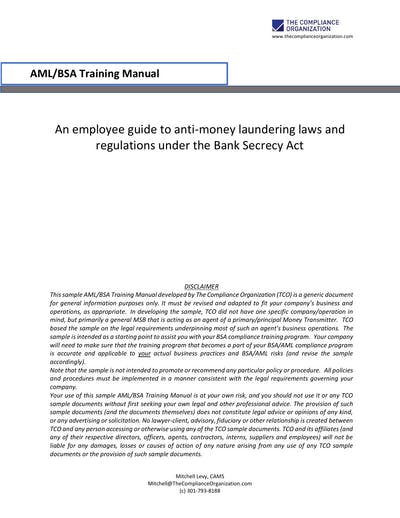
An Employee Guide To Anti-money Laundering Laws And
An Employee Guide To Anti-money Laundering Laws And Regulations Under The Bank Secrecy Act. Disclaimer
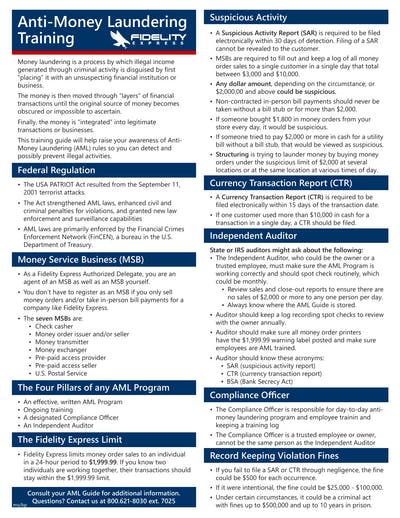
Anti-money Laundering Training
This Training Guide Will Help Raise Your Awareness Of Anti-. Money Laundering Aml Rules So You Can Detect And Possibly Prevent Illegal Activities
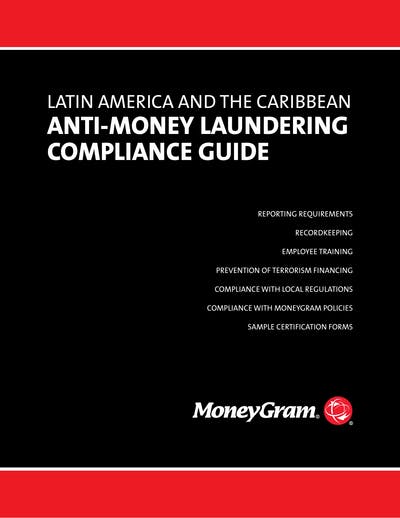
Anti-money Laundering Compliance Guide
An Ongoing Employee Training Program That: • Explains Policies And Procedures. • Teaches How To Identify Suspicious Activity
Explore more
Explore case studies
Learn how customers like you use SC Training (formerly EdApp). Their results speak for themselves.
Book a demo
Get a tour of our core products and features with one of our experts.
Take a bootcamp
Instantly access our video library updated weekly with live demonstrations.
Check out G2 reviews
Don't take our word for it. Here’s what our customers have to say.
And the best part? Your team can complete courses anytime, anywhere, on any device.
Sponsored by: Alogent

BSA/AML/OFAC Board Training
Devil Queen and Empress EGB combined their resources and created two versions of PowerPoint programs that you can use to train your board of directors for the Bank Secrecy Act/Anti-Money Laundering and OFAC. This is meant to be higher level material than is commonly used for BSA staff training, and is in two versions so that you can choose between more or less detail. The second version has one additional slide, 26 in total, but the contents of the slides are different, so you have a choice. There are even speaker's notes to assist you along the way.
First published on 02/01/2006
Report a problem with this page
Search Tools
- Main Tools Page
- Compliance Tools
- Lending Tools
- Operations Tools
- Security Tools
- Technology Tools
Submit a Tool
Contribute an original tool you have created
Learn about our FREE Briefings.
Sixth Money Laundering Directive Training (6AMLD/6MLD/AMLD6)
Duration: 20 minutes | format: editable ppt / pdf.
The EU published the 6th instalment of its money-laundering directives only 6 months after the 5th, to further strengthen its attempts to combat money laundering. The Sixth Anti-Money Laundering Directive (6AMLD) became law from 3rd December 2020 across member states. Organisations then have until the 3rd June 2021 to implement and comply with the new provisions. Although 6AMLD contains far fewer changes than 5AMLD, it requires businesses to be a lot more proactive. This tougher stance looks beyond the mechanics of compliance and instead focuses on tackling the heinous crimes enabled by money laundering (including trafficking, bribery, and so on). In short, it empowers firms to implement AML systems that truly protect the innocent.
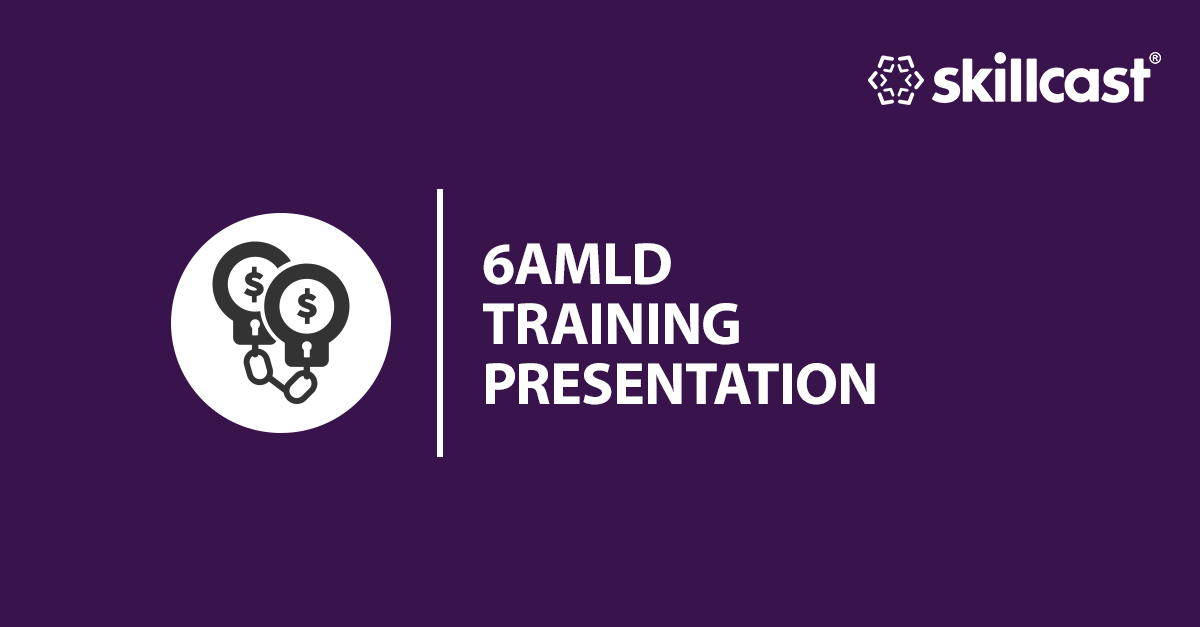
Learning objectives
Use our free 20-minute PowerPoint training presentation to help your colleagues understand what 6MLD means and the responsibilities they have.
- Understand what 6AMLD is
- Learn what is new and what has changed under 6AMLD
- Responsibilities for organisations and their employees
- How to prepare
- What to do, and what to avoid
- Financial penalties and individual sanctions
- Explain your company AML/CTF policy
Download your free training aid
Share this training aid.

Anti-Money Laundering Awareness Training
Sep 13, 2014
460 likes | 1.05k Views
Anti-Money Laundering Awareness Training. July 2007. Overview. This training session has been designed to provide you with information and guidance as to how to comply with your anti-money laundering (AML) responsibilities. It covers the following: What is money laundering?
Share Presentation
- money laundering
- criminal proceeds
- suspicious activity
- suspect money laundering
- kenya money laundering legislation

Presentation Transcript
Anti-Money Laundering Awareness Training July 2007
Overview • This training session has been designed to provide you with information and guidance as to how to comply with your anti-money laundering (AML) responsibilities. • It covers the following: • What is money laundering? • How does it affect Safaricom, its staff and Agents? • What are the rules & penalties? • How do we fight it? • AML Awareness Test AML Awareness Training
The Origin The original meaning of money laundering was a method by which the proceeds of crime are converted into assets that appear to have a legitimate origin, so that they can be retained permanently or recycled to fund further crimes. Money laundering got its name from a string of laundries that the Mafia used in the USA to front their illegal business. What is money laundering? AML Awareness Training
What is money laundering? Modern day money laundering The definition and scope of money laundering is a lot broader than the traditional ‘washing dirty money’ concept. It can be defined as: • Certain actions laid down in the Proceeds of Crime and Anti-Money Laundering Bill, October 2006 • These include concealing, acquiring, using or possessing the proceeds of crime or making arrangements for another person to acquire, use or possess criminal proceeds. • For the purposes of money laundering, the proceeds of crime include property or economic benefits a person would gain, directly or indirectly, as a result of an offence committed in Kenya or anywhere else, irrespective of whether committed before commencement of the Bill. So an offence of money laundering can be committed by a person merely having stolen goods in their possession. AML Awareness Training
Common origins of illegal money: Fraud Extortion Forgery Theft People Trafficking Drugs Smuggling Tax Evasion Terrorism How big is it? Although it’s almost impossible to say the exact amount laundered, it is estimated by the Revenue & Customs in the UK that the amount is... UK£ 25 BILLION a year What is money laundering? AML Awareness Training
What is money laundering? The 3 stages of money laundering The money laundering process is often described as taking place in three stages: PLACEMENT The physical disposal of the initial proceeds derived from illegal activity. LAYERING Separating illicit proceeds from their source by creating complex layers of transactions designed to disguise the audit trail and provide anonymity. INTEGRATION The provision of apparent legitimacy to criminally derived wealth. The laundered proceeds re-enter the financial system, appearing as normal funds. All three stages don’t have to occur for money laundering to have happened. If you suspect activity in any stage, always report your suspicion to the Money Laundering Reporting Officer (MLRO) – details of the MLRO are contained further on. AML Awareness Training
Money obtained through subscription fraud Money used to buy drugs to sell on Proceeds of drug sales need laundering • Loss suffered by company; • - May have involved an innocent customer. • Cost of fraud impacts the price of mobile services for legitimate customers. • Shareholders lose revenue. • Social harm; • Drug users forced to commit other crimes to pay for the drugs • Users are likely to suffer ill health and possibly untimely death. • Subsequent health problems costs the Government significant sums. • Potential further harm caused to society; • More drugs purchased • Money used to fund other crime • Channelled into terrorist cells What is money laundering? Impact on Society This scenario demonstrates how money laundering supports numerous activities which harm the society as a whole: AML Awareness Training
What is money laundering? Terrorist Financing Traditional Anti Money Laundering (AML) efforts have concentrated on criminal proceeds being laundered. The facilitation of the financing of prospective acts of terror is a different process of laundering the proceeds of crime but they do have features in common: When money is laundered it will be used to fund future criminal acts. The destination of money used to support terrorism has to be disguised in the same way that the source of laundered funds has to be disguised. Both often require assistance from financial products. Terrorist groups could be funded by criminal activities such as mobile phone related frauds BOTH HAVE TO BE REPORTED AML Awareness Training
All firms, whether offering financial services or not, should apply the principles of the regulatory obligations across the firm’s activities in the appropriate way. The Safaricom Money Transfer product will be covered by Kenya money laundering legislation. As a result you, as an Agent or Safaricom employee, have personal and legal responsibilities. This training session has been designed to provide you with information and guidance as to how to comply with these responsibilities. How does it affect Safaricom and you? AML Awareness Training
What are the rules & penalties? The legislation that affects you: • Proceeds of Crime & Anti-Money Laundering Bill 2006 The legislation covers ALL CRIME, no matter how small the financial gain. AML Awareness Training
What are the rules & penalties? Proceeds of Crime & Anti-Money Laundering Bill 2006 The 3 principal offences above carry a penalty of 14 years imprisonment and/or Sh 5M fine for individuals and for corporates, a fine of Sh 25M or value of the property involved, whichever is higher. The Bill contains 3 principle money laundering offences: • Concealing – Concealing, disguising, converting or transferring criminal property. • Arrangements (including terrorism) - Entering an arrangement which facilitates the acquisition, use or control of criminal or terrorist property by another person. • Acquisition, use and possession - of known or suspected criminal proceeds (or funds) AML Awareness Training
What are the rules & penalties? The 2 offences that Safaricom staff and agents ought to take note of are: • Failure to Disclose An offence is committed if you know or suspect or have reasonable grounds for knowing or suspecting that someone is engaging in money laundering and you did not report it a soon as practical to the Money Laundering Reporting Officer (MLRO). • Tipping Off A person commits an offence if they know that a disclosure has been made to the MLRO or the authorities, and makes a disclosure which is likely to prejudice any investigation. This includes dropping hints to the customer either intentionally or inadvertently and enteringinformation onto front end customer service systems. Proceeds of Crime & Anti-Money Laundering Bill 2006 These 2 offences carry a penalty of 7 years imprisonment and/or a fine not exceeding Sh 2.5M or in case of corporates, a fine of Sh 10M or the value of the property, whichever is higher. AML Awareness Training
What are the rules & penalties? Summary: You can be prosecuted for any of the five offences, or a combination of all five. The 5 money laundering offences under the Proceeds of Crime Act are: • Concealing • Arrangements (including terrorism) • Acquisition, Use and Possession • Failure to Disclose • Tipping Off AML Awareness Training
How do we fight it? Principal AML Controls • Know Your Customer (KYC) – Robust systems in place to verify the identity of our customers and understanding the nature of the relationship. • Recognition and Reporting of Suspicious Activity – All Safaricom staff and agents must be on the look out for suspicious activity and have the ability to report suspicions to the MLRO. • Education & Training of Staff and Agents – Giving you the knowledge to know what is suspicious and how to make a report. AML Awareness Training
How do we fight it? Know Your Customer • The first step in any ML operation is opening the accounts where the proceeds of crime can be placed. This is why confirmation of identity and KYC is crucial. Front line Staff and Agents are our first line of defence against money laundering and terrorist financing. • By knowing your customer, you will be able to understand what is potentially suspicious. • Transactions that are not consistent with the known circumstances of the customer, should raise suspicions. AML Awareness Training
How do we fight it? Reporting Suspicious Activity • The Proceeds of Crime &Anti-Money Laundering Bill makes it a criminal offence not make a report when you have reasonable grounds to suspect money laundering. • A sensible interpretation of ‘reasonable grounds for suspicion’ is that a reasonable and honest person would think that a customer’s behaviour was unusual - AND further think that the reason for this behaviour might be money laundering. • Unusual activity in isolation is not necessarily suspicious. Further investigation may reveal a logical explanation for the activity. • Where there is no logical explanation for an unusual transaction and the funds may be the proceeds of crime or being used to fund terrorism, it must be reported to the MLRO. The Suspicious Activity Reporting form is attached AML Awareness Training
How do we fight it? Red Flags – Typical examples of suspicious activity • Frequent, large-scale cash transactions Criminals often accumulate large amounts of low-denomination notes (e.g. drug dealers). The criminal must enter these notes into the financial system to realise their true value. • A typical or uneconomical fund transfer to or from a foreign jurisdiction The transfer of criminal funds brings several benefits to laundering operations. We should be on the lookout for fund transfers with no approved reason and no supporting explanation. • Large or rapid movements of funds Money launderers often try to 'layer' funds by switching between several accounts in different institutions or jurisdictions in an attempt to throw the auditors off their trail. A legitimate customer, by contrast, will usually try to minimize bureaucracy and fees. • Unrealistic wealth compared with customer profiles Be wary of individuals with little or no apparent wealth, or no employment, who pay large sums of money into accounts. Often these funds are directly derived from crime, or are being 'looked after' while the real criminal is being investigated by police. • Defensive stance to questioning Inexperienced launderers may not have prepared a reasonable cover story concerning the origins of their illicit funds. An 'honest' customer will, in general, be willing to answer questions about his finances because he wants the service provider to tailor its service to his needs. The Suspicious Activity Reporting form is attached AML Awareness Training
Complete a SAR form in soft copy and send to [email protected] . The form will automatically be receive by the MLRO. Do not display or communicate any suspicion to the customer or a colleague – if in doubt contact the Safaricom MLRO Do not tell the customer that you have reported them Do not add any memos on the system stating that a report has been made and remember to destroy any hard copies of the report that may have been produced. How do we fight it? Making a Suspicious Activity Report (SAR) AML Awareness Training
How do we fight it? Suspicious Activity Reporting Form Attached is the Suspicious Activity Report AML Awareness Training
How do we fight it? Who is the Money Laundering Reporting Officer (MLRO)? • The MLRO is the member of staff responsible for, among other things, the receipt, investigation and disclosure (where appropriate) of Suspicious Activity Reports to the Financial Reporting Centre. • The MLRO for Safaricom is Miriam Gikonyo. • The Fraud Manager for Safaricom is Edward Muchiri. • All Safaricom staff/Agents must use the Suspicious Activity Reporting (SAR) Form which will be sent to the above staff in Fraud management via [email protected] What is the 4D technique mentioned on the SAR form? The 4D technique will help you consider whether what you have seen may relate to criminal activity and is therefore suspicious or whether it is unusual but with a logical explanation. Unusual activity which is NOT suspicious should NOT be reported. The main headings of the 4D technique are as follows: • Details – What has happened? Do I need to know more? • Dates – When did it happen? Is it a one off transaction or a series of transactions? • Doubts – What made me suspect this relates to criminal activity? How well do I know the customer? Does anyone else know more? • Decision – You may decide; (i) That you are suspicious and therefore need to report the activity to the MLRO, (ii) Not to report it as you have concluded that there is a logical explanation for the activity, or (iii) Monitor the account to better understand the activity before making a final decision. AML Awareness Training
How do we fight it? What happens next to the report? The Money Laundering Reporting Officer will: • Gather additional evidence and fully investigate the circumstances surrounding the suspicion. • Decide whether or not to report to the Financial Reporting Centre • Advice the reporter if any action needs to be taken and whether or not the matter has been reported to the Reporting Centre.. • Liaise with the Centre during their investigation. The Suspicious Activity Reporting form is attached AML Awareness Training
Summary In this course you have learnt • The definition and process of money laundering. • How it affects Safaricom and you personally. • The legal requirements and consequences. • How to fight money laundering and terrorist financing as well as protect yourself and Safaricom. Be alert at all times - follow these AML Guidelines or contact Safaricom’s MLRO for advice AML Awareness Training
Knowledge Test • You will now be asked 10 questions on the subjects covered in this course. • You will be given your score at the end and will be required to re-take the test until you meet the pass mark of 70%. Good luck! AML Awareness Training
- More by User

Anti Money Laundering
http://www.infoglide.com/ Money laundering is the process by which criminally obtained money or other assets (criminal property) are exchanged for money or assets with no obvious link to their criminal origins. In the hands of the thief or money launderer, the converted funds or other assets always represent criminal property.
556 views • 6 slides

June 2007. AML Awareness Training. 2. Overview. This training session has been designed to provide you with information and guidance as to how to comply with your anti-money laundering (AML) responsibilities. It covers the following:What is money laundering? How does it affect Safaricom, its st
2.77k views • 24 slides

Infoglide Software provide money laundering, anti fraud, fraud detection, identity resolution, entity resolution Solutions through intelligent (id)entity matching and powerful non-obvious relationship nalysis across disparate data sources.
378 views • 7 slides

Anti-Money Laundering Provisions
Anti-Money Laundering Provisions. Jyotsna Chaturvedi Senior Associate MAHESHWARI & CO. Advocates & Legal Consultants Telephone: 91-11-2610 1906 Fax: 91-11-2617 1201 E-mail: [email protected]. Introduction.
649 views • 34 slides
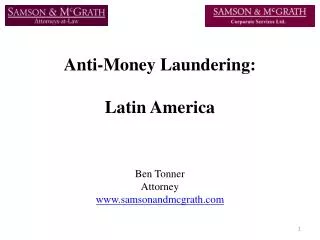
Anti-Money Laundering: Latin America
Anti-Money Laundering: Latin America . Ben Tonner Attorney www.samsonandmcgrath.com. OUTLINE. (Anti) Money Laundering The Financial Action Task Force AML, Trusts and Estates AML and Latin America Changes: the FATF 40 Recommendations Trends and Tips for the future. Money Laundering.
533 views • 26 slides


Anti-Money Laundering Policy
Anti-Money Laundering, Suspicious Activity Report and Fraud Policy Training Policy Effective Date August 13, 2012. Anti-Money Laundering Policy.
1.2k views • 88 slides

Anti-Money Laundering
2013 Global Ethics Summit. Anti-Money Laundering. March 5, 2013. Risk Based Approach to AML.
215 views • 5 slides

XYZ Bank University. Anti-Money Laundering. Awareness Training. XYZ Bank University. View Course or Take Assessment.
1.03k views • 16 slides
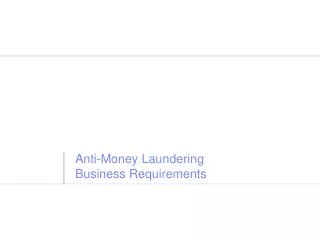
Anti-Money Laundering Business Requirements
Anti-Money Laundering Business Requirements. The basic AML business requirement is compliance with the USA Patriot Act and the underlying Bank Secrecy Act. These Acts lay out three basic categories of anti-money laundering requirements: Know Your Customer (KYC)
345 views • 14 slides
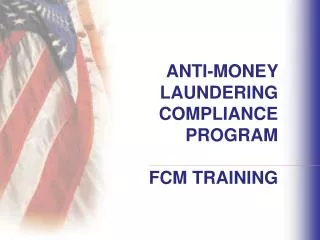
ANTI-MONEY LAUNDERING COMPLIANCE PROGRAM FCM TRAINING
ANTI-MONEY LAUNDERING COMPLIANCE PROGRAM FCM TRAINING. Stages of Money Laundering. Placement Layering Integration. Anti-Money Laundering Program Rule 2-9(c). Policies, Procedures and Internal Controls Designated Compliance Officer Ongoing Training Independent Audit Function.
916 views • 40 slides
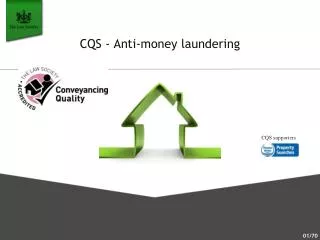
CQS - Anti-money laundering
CQS - Anti-money laundering. CQS supporters. 01/70. Course author. This training course and assessment has been prepared by Emma Oettinger, former Law Society anti-money laundering policy officer.
1.73k views • 114 slides

Anti-Money Laundering (AML)
Anti-Money Laundering (AML). What is AML?. The Financial Crimes Enforcement Network (FinCEN) requires that all nonbank mortgage lenders and originators implement an Anti-Money Laundering program.
1.35k views • 11 slides

Anti-Money Laundering (“AML”)
Anti-Money Laundering (“AML”). What is Money Laundering?. The concealing or disguising the existence, illegal source, movement, destination or illegal application of illicitly derived property or funds to make them appear legitimate. The three stages of Money Laundering:
1.86k views • 42 slides

Anti-Money Laundering. Anita M. Moyer, MSP, CAMS. Banking Crisis Humor. This credit crunch is worse than a divorce. I've lost half my net worth and I still have a spouse. Banking Crisis Humor. I went to the ATM this morning and it said "insufficient funds."
897 views • 30 slides

Anti - Money laundering
Anti - Money laundering. Presented by the Inspired Learning Regulatory Academy. Anti Money laundering. Source: Section 2 General Code of Conduct.
560 views • 12 slides

Anti-Money Laundering. European Commission. DG Internal Market and Services David Schwander. The European future priorities in tackling money laundering ALDA Brussels, 09.10.2014. The issue…. Criminal proceeds: US$ 2.1 trillion in 2009
380 views • 14 slides

Anti-Money Laundering Presentation for the Central Bank of Libya Royce Walker Financial Services Volunteer Corps Volunteer March 23 - 25, 2009. Anti-Money Laundering. Introduction Topics of Discussion: Definition of Money Laundering How Money Laundering is Accomplished
1.27k views • 56 slides
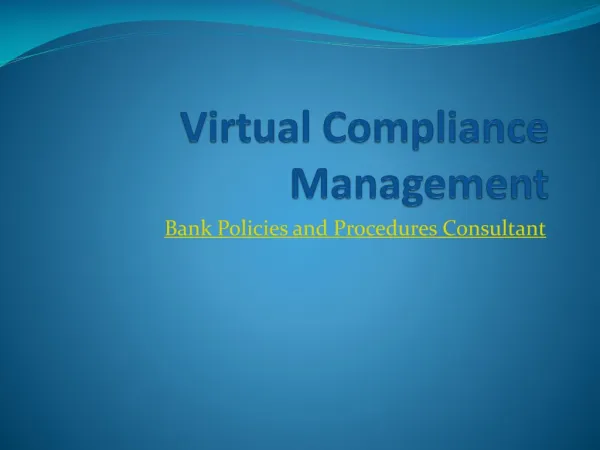
Anti Money Laundering Compliance
Virtual Compliance Solution,complete Anti Money Laundering Compliance resource for Banks.
142 views • 4 slides

Anti-Money Laundering Training in Guernsey
By adhering to the AML policies, most of the organisations that complete financial transactions need to ensure thorough records of their customer's accounts and activities. In case, a suspicious activity appears, the entity is requested to report it to the government. Active Group Ltd offers AML training in Guernsey on how to implement and abide by AML policies for company's benefits. https://www.activeoffshore.com/aml-training-guernsey/
119 views • 7 slides
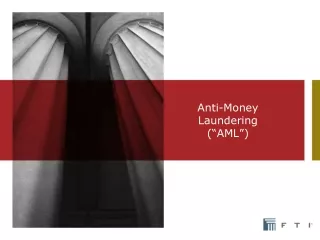
608 views • 42 slides

Anti Money Laundering (AML)
Anti Money Laundering (AML). An Overview for Staff Prepared by MSM Compliance Services Pty Ltd. Who Are MSM Compliance?. MSM is a national professional services business focused on the general insurance industry.
679 views • 16 slides

238 views • 14 slides

Art - Refresher & Government Updates AML Training - 2nd October 2024
It is a legal requirement for all relevant Art Market Participants to receive AML training and to stay up-to-date with the current rules.
Date and time
Refund policy, about this event.
- Event lasts 1 hour 30 minutes
Our experts at FCS Compliance offer comprehensive training for all levels of staff to support compliance with Regulation 24 of the Money Laundering Regulations 2017. We are established trainers with extensive knowledge of primary and secondary legislation, and are chosen as the Approved Service Provider for LAPADA, to help raise standards and minimise the risk of criminal activity within regulated businesses.
This CPD-certified refresher course will ensure that employees stay up-to-date with the current rules. The course will be carried out remotely, via Zoom, and those attending must have previous experience of attending an anti-money laundering foundation level course in order to meet legal requirements.
Course Details
Foundation (Top-Up Session)
Programme summary
Anti-Money Laundering Compliance Training ~ Art Sector (Top Up Session & Government Updates)
The course is scheduled for Wednesday 2nd October at 10am-11.30am and will cover the following topics:
Money Laundering Regulations 2017
- Summary of Regulatory Offences
- Customer Due Diligence
- Commencing a business relationship
- Beneficial ownership
- Risk rating of clients
- Reliance on third parties
- Record keeping
- CDD Checklist and recommended documents
Conducted by one of our highly-experienced experts, you will be provided with the all-important certificate for your training log after completion of the programme.
Rate: £145+ VAT per person (£115+VAT per person if an FCS Subscriber)
Additional Information
- Please ensure you are logged into the training session 10 minutes beforehand as the course will commence promptly at 10am. Delegates will not be permitted access after 10:15am. Cameras must be turned on throughout as this is a CPD-certified course.
- You will receive a course handout and the Zoom access links prior to the course.
- Delegates must attend the full session to receive a certificate upon completion of the online course.
- Please email Annie at FCS Compliance ([email protected]) should you have any questions or require assistance.
Terms and Conditions
The person booking is responsible for supplying the correct contact information. Substitute delegates may attend at no additional cost, however please email [email protected] regarding this change at least 24 hours before the event.
Refunds in respect of cancellations can only be made if cancellations are received in writing at least 7 days before the event, and will be subject to a 50% administrative charge. Cancellations received after this period will be charged 100% of the course fee. Please note that non-attendance (without prior notification) is subject to a 100% cancellation fee.
FCS Compliance Ltd reserves the right to alter the programme and/or the speakers at any time and without prior notice, and also reserves the right to cancel an event, in which case all fees will be refunded.
- Online Events
- Things To Do Online
- Online Classes
- Online Business Classes
- #antimoneylaundering
- #amltraining
Organised by
- Open access
- Published: 06 August 2024
Assessing the interplay of presentation and competency in online video examinations: a focus on health system science education
- Phoomjai Sornsenee 1 ,
- Pawita Limsomwong 1 ,
- Polathep Vichitkunakorn 1 ,
- Supakorn Sripaew 1 ,
- Supinya Sono 1 ,
- Kanisorn Sungkaro 2 ,
- Theepat Wongkittithaworn 3 ,
- Thadakorn Tantisarasart 4 ,
- Pongphon Chuchuen 5 ,
- Katti Sathaporn 6 &
- Kwanchanok Chantaramanee 7
BMC Medical Education volume 24 , Article number: 842 ( 2024 ) Cite this article
109 Accesses
1 Altmetric
Metrics details
The integration of Health System Science (HSS) in medical education emphasizes mastery of competencies beyond mere knowledge acquisition. With the shift to online platforms during the COVID-19 pandemic, there is an increased emphasis on Technology Enhanced Assessment (TEA) methods, such as video assessments, to evaluate these competencies. This study investigates the efficacy of online video assessments in evaluating medical students’ competency in HSS.
A comprehensive assessment was conducted on first-year medical students ( n = 10) enrolled in a newly developed curriculum integrating Health System Science (HSS) into the Bachelor of Medicine program in 2021. Students undertook three exams focusing on HSS competency. Their video responses were evaluated by a panel of seven expert assessors using a detailed rubric. Spearman rank correlation and the Interclass Correlation Coefficient (ICC) were utilized to determine correlations and reliability among assessor scores, while a mixed-effects model was employed to assess the relationship between foundational HSS competencies (C) and presentation skills (P).
Positive correlations were observed in inter-rater reliability, with ICC values suggesting a range of reliability from poor to moderate. A positive correlation between C and P scores was identified in the mixed-effects model. The study also highlighted variations in reliability and correlation, which might be attributed to differences in content, grading criteria, and the nature of individual exams.
Our findings indicate that effective presentation enhances the perceived competency of medical students, emphasizing the need for standardized assessment criteria and consistent assessor training in online environments. This study highlights the critical roles of comprehensive competency assessments and refined presentation skills in online medical education, ensuring accurate and reliable evaluations.
Peer Review reports
In medical education, assessment extends beyond mere knowledge acquisition. It emphasizes the mastery of essential skills and the medical profession. [ 1 ] Among various approaches, competency-based assessment stands out, [ 2 ] as it encompasses the full range of knowledge, skills, and attitudes. [ 3 ] This approach focuses extensively on Health System Science (HSS), which is globally recognized as the third pillar of medical education. [ 4 ] HSS integrates systems thinking and the complexities of healthcare systems, equipping medical professionals to adeptly navigate and manage the socio-economic, political, and interpersonal factors influencing healthcare. [ 5 ] Furthermore, the cognitive domain is an integral facet of HSS, emphasizing Higher-Order Thinking (HOT) skills, such as critical thinking, problem-solving, and analytical reasoning. [ 6 , 7 ] These skills are crucial to effectively engaging with the broader constructs of HSS.
The challenges brought by the COVID-19 pandemic have reshaped traditional teaching and prompted a re-evaluation of existing assessment methods. [ 8 , 9 , 10 ] Global institutions, faced with the limitations of in-person interactions, have found it essential to transition to digital platforms. [ 10 ] This shift has highlighted the need for adopting Technology Enhanced Assessment (TEA) methods, which align well with the emerging online teaching environment. [ 11 , 12 ] In this new paradigm, it is crucial that TEA methods, especially online video assessments, effectively evaluate competencies for the digital age. However, their efficacy in specific areas like HSS remains under exploration.
Oral presentations, especially in online video formats, may offer unique insights into a student’s HOT capabilities, which are essential for HSS assessments. These evaluations could potentially elucidate core areas within HSS, such as systems thinking, health policy, and the social sciences. Previous studies hint at the efficacy of oral assessments in areas like social sciences [ 13 ] and professionalism. [ 14 ] However, the robustness and reliability of video-based oral presentations as an assessment tool warrant further investigation. Another consideration is the potential bias resulting from varying presentation skills. [ 15 , 16 ] Students with exemplary presentation skills may overshadow essential content gaps, while those less adept at presenting might not be duly acknowledged for their depth of HSS knowledge. To ensure fair and effective assessment, it is critical to carefully differentiate true competency from mere presentation prowess.
In this study, we investigate the effectiveness of online video assessments in capturing medical students’ competency in the HSS curriculum, focusing on topics like systems thinking, health policy, medical ethics, and social health determinants. Our research primarily aims to gauge score consistency across assessors. We employ the Interclass Correlation Coefficient (ICC) to measure inter-rater reliability and use Spearman’s Rho—a statistical method—to determine correlations among assessors. Alongside, we explore the relationship between foundational HSS competenies (C) and presentation skills (P) through mixed-effects modeling. Elucidating the interplay between C and P offers a nuanced perspective for HSS assessments.
Study design, setting, and participants
The study involved a comprehensive assessment of all first-year medical students ( n = 10) enrolled in a newly developed curriculum integrating Health System Science (HSS) into the Bachelor of Medicine program in 2021. The curriculum aims primarily at two objectives. First, it seeks to provide comprehensive medical education enriched with HSS concepts. Second, it intends to attract students from rural areas, nurturing them with the hope they will return and serve their home communities, equipped with a deep understanding of the public health system.
Examination process
First-year medical students undertook three distinct exams, each designed to assess various dimensions and complexities of Higher-Order Thinking (HOT) skills within the Health System Science (HSS) curriculum. For a detailed breakdown of exam formats, materials, and timing, refer to Table 1 .
Exam 1 on Social Health Determinants (SDHs) : This exam assesses foundational HOT skills such as understanding, recall, and application, in addition to critical thinking and problem-solving. It integrates theoretical and practical elements to evaluate how students apply systems thinking to real-world health challenges.
Exam 2 on Health Care Policy : This exam focuses on deeper analytical and synthetic HOT skills, evaluating students’ abilities to critically engage with and construct reasoned arguments regarding health policy issues.
Exam 3 on Medical Ethics : Similarly, this exam tests the students’ ability to analyze, synthesize, and evaluate ethical dilemmas in medical practice, enhancing their understanding of the ethical frameworks essential to health system science.
Each exam incorporates elements of systems thinking, foundational to mastering HSS. The assessments were developed by an impartial educator and are conducted over a standardized 40-minute session, utilizing a Learning Management System (LMS) developed by the faculty of medicine.
Assessment technique and evaluation
After the three exams, students’ response videos were assessed by a panel of seven expert assessors specializing in medical education. The assessment process utilized a detailed rubric, designed to capture the depth and nuance of HOT as intended in each exam. This rubric, informed by the principles of HOT and HSS, combined a numerical scale (ranging from 1 to 10) with explicit descriptors for each score, providing clarity on performance expectations. This ensured evaluations were consistent and adequately represented the depth of student understanding in relation to the complexities integrated into the three exams. The training of our panel of assessors focused on the foundational principles of Health System Science (HSS) and the effective application of the assessment rubric. The initial session introduced the assessors to the rubric, highlighting its alignment with key HSS competencies such as systems thinking and value based care. This included a detailed explanation of the scoring system and performance standards.
The students were assessed based on two primary criteria. First , their competency skills were evaluated using the rubric formulated by the educational research team to capture the nuances of HOT. Second , their presentation skills were assessed, focusing on accuracy, clarity, and the effectiveness of their communication, drawing from criteria established in previous research. [ 16 ]
Statistical analysis and reliability assessment
Assessor Score Correlation : We utilized the Spearman rank correlation method to understand the interrelationships among assessor scores. Data for each of the three exams (Exams 1–3) are presented in tables, which display the Spearman’s rho coefficients for competency (C) scores and presentation (P) scores. A rho value near 1 signifies a strong correlation; a value between 0.5 and 0.75 indicates a moderate correlation; a value between 0.3 and 0.5 suggests a weak correlation; and a value close to 0 implies negligible correlation.
Reliability Estimation : The level of agreement among assessors was quantified using the Interclass Correlation Coefficient (ICC). Each ICC value was complemented with its respective 95% confidence interval. It is essential to note the interpretative context of the ICC values: those below 0.5 signify poor reliability; values ranging from 0.5 to 0.75 denote moderate reliability; values between 0.75 and 0.9 are indicative of good reliability; and values exceeding 0.9 are demonstrative of excellent reliability.
Relationship between Presentation and Competency : A jitter plot depicted individual student performances, with colors differentiating each assessor. A mixed-effects model was implemented to consider potential variability due to individual assessors. The model’s coefficient indicated the anticipated shift in competency relative to presentation skills.
Software and Packages : All analytical processes, from data visualization to heat map creation, were executed using R software, version 4.3.1 with packages. [ 17 , 18 , 19 , 20 ]
Our evaluation offers insights into both the correlation and reliability of assessments. The 10 participants, scores across the three exams were evaluated by seven expert assessors. Spearman’s Rho values, as illustrated in Tables 2 and 3 , indicate correlations for competency scores (C) and presentation scores (P). All correlations emerged as positive; however, there were discernible variations in strength from weak to strong for both competency and presentation scores across different assessors and exams. The Interclass Correlation Coefficient (ICC) values for C scores across exams were 0.42 (95% CI = 0.18–0.74) for Exam 1, 0.27 (95% CI = 0.09–0.61) for Exam 2, and 0.35 (95% CI = 0.12–0.68) for Exam 3. P scores for these exams were 0.44 (95% CI = 0.20–0.75) for Exam 1, 0.32 (95% CI = 0.12–0.66) for Exam 2, and 0.48 (95% CI = 0.24–0.78) for Exam 3. When considering the 95% confidence intervals for both competency and presentation scores, these ICC values suggest a range of reliability from poor to moderate.
Further exploration of the correlation between C and P scores across the three exams is depicted in Figs. 1 and 2 , and 3 , respectively. Each figure presents a jitter plot that highlights individual data points; different colors represent individual assessors. The overall mixed-effects model prediction is captured by a red dotted line, flanked by the 95% confidence interval (CI). For Exam 1, the model indicates a positive correlation between C and P scores with a coefficient of 0.16, but this is not statistically significant ( p = 0.073). In contrast, both Exams 2 and 3 consistently showed statistically significant positive correlations between C and P scores, with all assessors reflecting this trend.
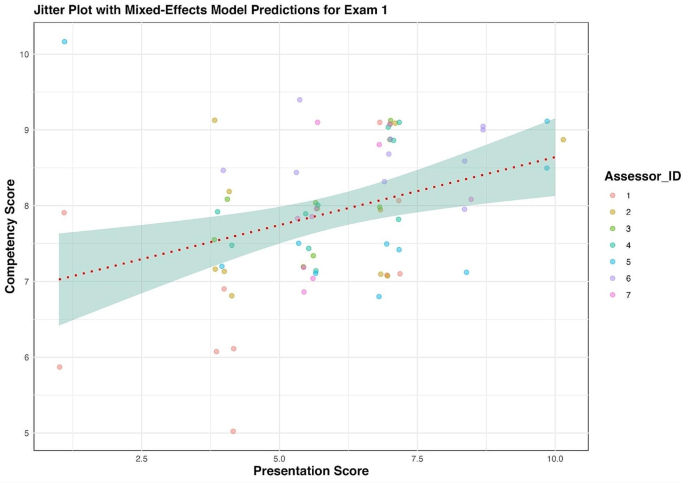
Jitter plot of exam 1 with individual assessor lines and mixed-effects model correlating competency and presentation scores
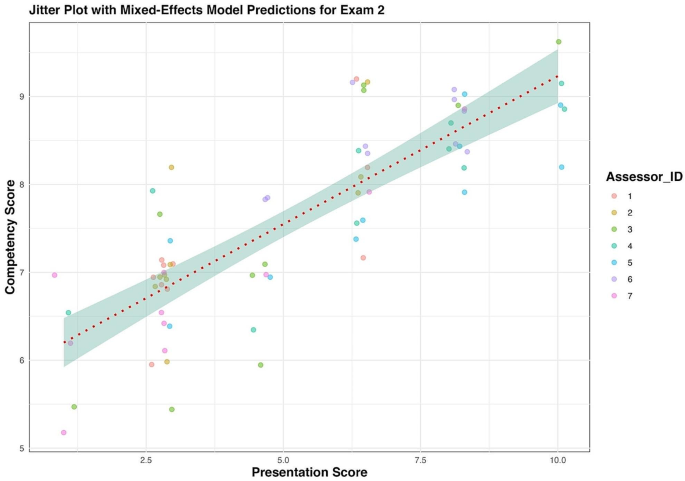
Jitter plot of exam 2 with individual assessor lines and mixed-effects model correlating competency and presentation scores
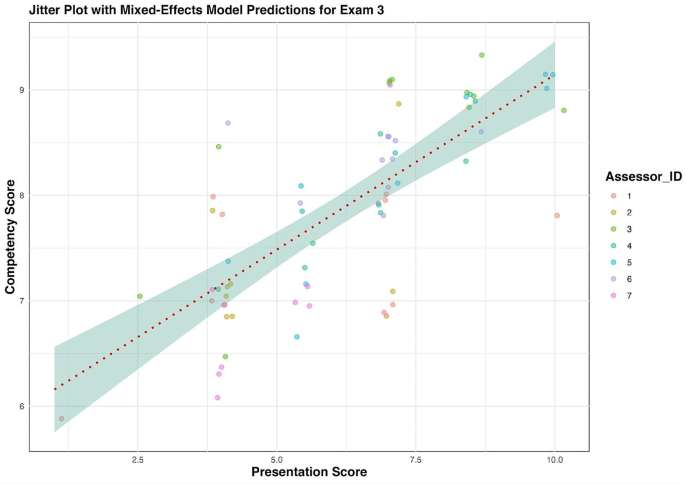
Jitter plot of exam 3 with individual assessor lines and mixed-effects model correlating competency and presentation scores
Medical education, especially in areas like HSS, has significantly evolved due to global trends. As digital platforms have surged in popularity, exacerbated by the COVID-19 pandemic, the emphasis on online assessments has grown. Our study, deeply rooted in HSS, sheds light on the broader challenges of online evaluations. Specifically, it underscores the balance required between content mastery and effective presentation in an environment where both are paramount.
One key finding from our study is the role of assessor calibration. Using statistical measures like ICC and Spearman’s rho, we observed a positive correlation in inter-rater reliability, accompanied by variations. It is imperative to recognize that our research’s primary objective was not solely to evaluate the efficiency of our rubric scores but to scrutinize the efficacy of our video assessment design for HSS. Prior studies support our conclusions, suggesting that rubric-based grading can have varying reliability. [ 21 , 22 , 23 ] Such deviations can arise due to factors including the content under examination, the adopted grading criteria, statistical evaluation methods, the nature of the test, and the number of involved assessors or participants. [ 21 , 24 ]
In addressing the challenges of evaluating complex topics such as healthcare politics and policies, our assessor training was tailored to enhance the use of a comprehensive rubric and objective assessment skills. The training included detailed reviews of HSS case studies and scenario-based exercises, emphasizing strategies to mitigate personal biases and maintain consistency across varied content. This approach helped ensure that all assessors were equipped to objectively assess responses, even in subjects prone to subjective interpretation. Upon deeper observation, we found that Exam 2 showed a lower correlation among scorers compared to Exams 1 and 3. This could be attributed to the content of Exam 2, which focused on healthcare politics and policies. Such policy-oriented topics can lead to varied interpretations among assessors, making it challenging to determine a universally acceptable answer. [ 25 ]
Our research underscores the crucial balance between competency and presentation skills. With the rise of digital platforms, the ability to articulate and communicate effectively has become indispensable for professional competency. [ 26 ] A related study, utilizing platforms like Zoom for assessments, aligns with our findings. [ 27 ] It emphasizes that when evaluating online, it is essential to distinguish domains like metacognition and creativity. Many evaluation methodologies prioritize oral presentation capabilities, relegating content knowledge to a secondary role. [ 14 , 15 , 28 ] In disciplines demanding HOT skills, such as HSS, merging these domains could potentially obscure the importance of specific competencies. Therefore, to ensure fair and effective assessments, it is vital to carefully differentiate between true competency and the enhancement effect of presentation prowess. This vigilance is crucial because exemplary presentation skills can sometimes overshadow gaps in content knowledge, while less polished presentation skills might lead to underestimation of a student’s understanding and competence. In response to this challenge, educational institutions should incorporate robust communication and presentation training modules into their curricula. [ 28 ] This would ensure that graduates are not only well-versed in their fields but also adept at articulating their knowledge.
Reflecting on our video assessment approach in HSS, the novel method we employed to understand the nexus between competency and presentation skills emerges as a strength. With the prevailing trend of transitioning to digital platforms in medical education, our insights stress the essence of both thorough content comprehension and proficient communication.
In our study, we employed a numeric scoring scale to quantify student performances, which provides precision and facilitates straightforward comparison. This method offers the advantage of detailed quantification, allowing for fine distinctions between levels of competency. However, it may introduce inconsistencies, especially when assessing complex competencies that require nuanced judgment. Alternatively, ordinal rating systems, which categorize performances into descriptive levels such as excellent, good, fair, or poor, can simplify assessments and potentially enhance consistency by more clearly delineating broad performance categories. Each system has its merits, with numeric scales offering granularity and ordinal scales providing clearer benchmarks. [ 29 ] This distinction underscores a key aspect of our current methodology and presents a valuable area for future research to explore the optimal balance between detailed quantification and categorical assessment in evaluating both competency and presentation skills in medical education.
In this study, we intentionally employed a diverse panel of seven expert assessors rather than the conventional use of two raters. This decision was guided by the aim to enhance the reliability and depth of our evaluations, particularly given the complex competencies involved in HSS. A larger panel allows for a more comprehensive range of perspectives on student performances, which is critical in a field where subjective judgment can significantly influence scoring. However, this approach can also introduce variability in scoring due to differences in each rater’s interpretation and emphasis, which might not be as pronounced with a smaller, more uniform panel. By using seven raters, we aimed to capture a broader spectrum of interpretations, which, while enriching the assessment, could also lead to increased score dispersion and affect the overall consistency of the results. This aspect of our methodology could have influenced the outcomes by either mitigating or exaggerating individual biases, thus impacting the inter-rater reliability as reported. To address these challenges, integrating AI technology could provide a valuable tool. Artificial intelligence can assist in standardizing evaluations by consistently applying predefined criteria, potentially reducing the variability introduced by multiple human assessors. [ 30 , 31 ] This hybrid approach, blending human insight with AI precision, represents a promising direction for future research, aiming to balance depth and reliability in complex competency assessments.
Considering the observed shift towards online assessments in medical education, this study sought to evaluate the efficacy of video assessments in measuring both competency and presentation skills within the Health System Science (HSS) framework. Our findings reveal positive correlations between these skills, indicating that effective presentation can enhance the perception of competency. However, variations in inter-rater reliability highlight the necessity for standardized assessment criteria and consistent assessor training. By implementing these strategies, educational institutions can ensure greater accuracy and reliability, which is crucial for accurately assessing student competencies in a digital learning environment. Thus, our study substantiates the importance of both thorough competency assessment and the enhancement of presentation skills in online medical education.
Data availability
The dataset analysed in the current study is available upon request from the corresponding author.
Astin AW. Assessment for excellence: the philosophy and practice of assessment and evaluation in higher education. Rowman & Littlefield; 2012.
Frank JR, Mungroo R, Ahmad Y, Wang M, De Rossi S, Horsley T. Toward a definition of competency-based education in medicine: a systematic review of published definitions. Med Teach. 2010;32(8):631–7.
Article Google Scholar
Ng IK, Mok SF, Teo D. Competency in medical training: current concepts, assessment modalities, and practical challenges. Postgrad Med J. 2024;qgae023.
Skochelak SE. Health systems science. Elsevier Health Sciences; 2020.
Gonzalo JD, Dekhtyar M, Starr SR, Borkan J, Brunett P, Fancher T, et al. Health systems science curricula in undergraduate medical education: identifying and defining a potential curricular framework. Acad Med. 2017;92(1):123–31.
Lewis A, Smith D. Defining higher order thinking. Theory into Pract. 1993;32(3):131–7.
Schraw G, Robinson DH. Assessment of higher order thinking skills. 2011.
Adedoyin OB, Soykan E. Covid-19 pandemic and online learning: the challenges and opportunities. Interact Learn Environ. 2020;1–13.
García-Peñalvo FJ, Corell A, Abella-García V, Grande-de-Prado M. Recommendations for mandatory online assessment in higher education during the COVID-19 pandemic. Radical solutions for education in a crisis context. Springer; 2021. pp. 85–98.
Pokhrel S, Chhetri R. A literature review on impact of COVID-19 pandemic on teaching and learning. High Educ Future. 2021;8(1):133–41.
Khan RA, Jawaid M. Technology enhanced assessment (TEA) in COVID 19 pandemic. Pakistan J Med Sci. 2020;36(COVID19–S4):S108.
Google Scholar
Fuller R, Joynes V, Cooper J, Boursicot K, Roberts T. Could COVID-19 be our ‘There is no alternative’(TINA) opportunity to enhance assessment? Med Teach. 2020;42(7):781–6.
Hazen H. Use of oral examinations to assess student learning in the social sciences. J Geogr High Educ. 2020;44(4):592–607.
Huxham M, Campbell F, Westwood J. Oral versus written assessments: a test of student performance and attitudes. Assess Evaluation High Educ. 2012;37(1):125–36.
Memon MA, Joughin GR, Memon B. Oral assessment and postgraduate medical examinations: establishing conditions for validity, reliability and fairness. Adv Health Sci Educ. 2010;15:277–89.
Chiang YC, Lee HC, Chu TL, Wu CL, Hsiao YC. Development and validation of the oral presentation evaluation scale (OPES) for nursing students. BMC Med Educ. 2022;22(1):318.
Bates D, Mächler M, Bolker B, Walker S. Fitting linear mixed-effects models using lme4. arXiv preprint arXiv:14065823. 2014.
Lüdecke D. Ggeffects: tidy data frames of marginal effects from regression models. J Open Source Softw. 2018;3(26):772.
Wei T, Simko V, Levy M, Xie Y, Jin Y, Zemla J. Package ‘corrplot ’ Stat. 2017;56(316):e24.
Gamer M, Lemon J, Gamer MM, Robinson A. Kendall’s W. Package ‘irr.’ Various coefficients of interrater reliability and agreement. 2012;22:1–32.
Jonsson A, Svingby G. The use of scoring rubrics: reliability, validity and educational consequences. Educational Res Rev. 2007;2(2):130–44.
Reddy YM, Andrade H. A review of rubric use in higher education. Assess Evaluation High Educ. 2010;35(4):435–48.
Brookhart SM, Chen F. The quality and effectiveness of descriptive rubrics. Educational Rev. 2015;67(3):343–68.
Dawson P. Assessment rubrics: towards clearer and more replicable design, research and practice. Assess Evaluation High Educ. 2017;42(3):347–60.
Musick DW. Policy analysis in medical education: a structured approach. Med Educ Online. 1998;3(1):4296.
Akimov A, Malin M. When old becomes new: a case study of oral examination as an online assessment tool. Assess Evaluation High Educ. 2020;45(8):1205–21.
Maor R, Levi R, Mevarech Z, Paz-Baruch N, Grinshpan N, Milman A et al. Difference between zoom-based online versus classroom lesson plan performances in creativity and metacognition during COVID-19 pandemic. Learning Environ Res [Internet]. 2023 Feb 21 [cited 2023 Aug 22]; https://link.springer.com/ https://doi.org/10.1007/s10984-023-09455-z
Murillo-Zamorano LR, Montanero M. Oral presentations in higher education: a comparison of the impact of peer and teacher feedback. Assess Evaluation High Educ. 2018;43(1):138–50.
Yen WM, THE CHOICE OF SCALE FOR EDUCATIONAL. MEASUREMENT: AN IRT PERSPECTIVE. J Educational Meas. 1986;23(4):299–325.
Ndiaye Y, Lim KH, Blessing L. Eye tracking and artificial intelligence for competency assessment in engineering education: a review. Front Educ [Internet]. 2023 Nov 3 [cited 2024 Jul 14];8. https://www.frontiersin.org/journals/education/articles/ https://doi.org/10.3389/feduc.2023.1170348/full
Khan S, Blessing L, Ndiaye Y. Artificial Intelligence for Competency Assessment in Design Education: A Review of Literature. In: Chakrabarti A, Singh V, editors. Design in the Era of Industry 40, Volume 3 [Internet]. Singapore: Springer Nature Singapore; 2023 [cited 2024 Jul 14]. pp. 1047–58. (Smart Innovation, Systems and Technologies; vol. 346). https://link.springer.com/ https://doi.org/10.1007/978-981-99-0428-0_85
Download references
Acknowledgements
We wish to thank the Department of Family Medicine and Preventive Medicine at Prince of Songkla University for supporting our research endeavors. Our gratitude is also extended to Assistant Professor Kanyika Chamniprasas, Vice Dean for Education, and Assistant Professor Supaporn Dissaneevate for their roles in creating and backing the health system reform curriculum for medical students, which contributed to this study.
No funding was received for this research.
Author information
Authors and affiliations.
Department of Family Medicine and Preventive Medicine, Faculty of Medicine, Prince of Songkla University, 15 Karnjanavanich Rd., Hat Yai, 90110, Songkhla, Thailand
Phoomjai Sornsenee, Pawita Limsomwong, Polathep Vichitkunakorn, Supakorn Sripaew & Supinya Sono
Division of Neurosurgery, Department of surgery, Faculty of medicine, Prince of Songkhla University, Kho Hong, Hat Yai District, 90110, Songkhla, Thailand
Kanisorn Sungkaro
Division of Head and neck surgery, Department of otolaryngology, Faculty of medicine, Prince of Songkhla University, Kho Hong, Hat Yai District, Songkhla, Thailand
Theepat Wongkittithaworn
Department of Anesthesiology, Faculty of medicine, Prince of Songkhla University, Kho Hong, Hat Yai District, 90110, Songkhla, Thailand
Thadakorn Tantisarasart
Department of Rehabilitation Medicine, Faculty of medicine, Prince of Songkhla University, Kho Hong, Hat Yai District, 90110, Songkhla, Thailand
Pongphon Chuchuen
Department of Psychiatry, Faculty of medicine, Prince of Songkhla University, Kho Hong, Hat Yai District, 90110, Songkhla, Thailand
Katti Sathaporn
Department of Emergency Medicine, Faculty of medicine, Prince of Songkhla University, Kho Hong, Hat Yai District, 90110, Songkhla, Thailand
Kwanchanok Chantaramanee
You can also search for this author in PubMed Google Scholar
Contributions
All authors made a significant contribution to the reported work. P.S., P.L. S.So., T.T., P.C, K.S., K.C. designed the study and obtained research ethics approval; P.S., P.V., S.Sr., K.S., and T.W., analysed and visualized the data; all authors interpreted the results, drafted, and revised the manuscript, and read and approved the final version of the manuscript.
Corresponding author
Correspondence to Phoomjai Sornsenee .
Ethics declarations
Ethics approval and consent to participate.
This study was approved by the Human Research Ethics Committee (HREC), Faculty of Medicine, Prince of Songkla University, on March 12, 2022. (Approval Number: REC REC.65-114-9-1). HREC is official institute responsible for the ethical review and supervision of human research. The study was conducted in accordance with the Declaration of Helsinki. All participants and/or their legal guardian(s) provided electronic informed consent before participating in the study, in accordance with established procedures. All questionnaires were fully computerised by the researchers and anonymised to ensure confidentially.
Consent for publication
Not applicable.
Competing interests
The authors declare no competing interests.
Additional information
Publisher’s note.
Springer Nature remains neutral with regard to jurisdictional claims in published maps and institutional affiliations.
Rights and permissions
Open Access This article is licensed under a Creative Commons Attribution-NonCommercial-NoDerivatives 4.0 International License, which permits any non-commercial use, sharing, distribution and reproduction in any medium or format, as long as you give appropriate credit to the original author(s) and the source, provide a link to the Creative Commons licence, and indicate if you modified the licensed material. You do not have permission under this licence to share adapted material derived from this article or parts of it.The images or other third party material in this article are included in the article’s Creative Commons licence, unless indicated otherwise in a credit line to the material. If material is not included in the article’s Creative Commons licence and your intended use is not permitted by statutory regulation or exceeds the permitted use, you will need to obtain permission directly from the copyright holder.To view a copy of this licence, visit http://creativecommons.org/licenses/by-nc-nd/4.0/ .
Reprints and permissions
About this article
Cite this article.
Sornsenee, P., Limsomwong, P., Vichitkunakorn, P. et al. Assessing the interplay of presentation and competency in online video examinations: a focus on health system science education. BMC Med Educ 24 , 842 (2024). https://doi.org/10.1186/s12909-024-05808-1
Download citation
Received : 21 August 2023
Accepted : 22 July 2024
Published : 06 August 2024
DOI : https://doi.org/10.1186/s12909-024-05808-1
Share this article
Anyone you share the following link with will be able to read this content:
Sorry, a shareable link is not currently available for this article.
Provided by the Springer Nature SharedIt content-sharing initiative
- Health system science
- Online video assessments
- Competency-based assessment
- Presentation skills
- Medical curriculum
BMC Medical Education
ISSN: 1472-6920
- Submission enquiries: [email protected]
- General enquiries: [email protected]

COMMENTS
Anti-money laundering training: PowerPoint example This PowerPoint presentation can be adapted to suit the training requirements of your practice. Anti-money laundering: PowerPoint example (updated June 2021)
PowerPoint presentation slides. Presenting Training Deck on Anti Money Laundering and Compliance Program. This deck comprises of 38 slides. Each slide is well crafted and designed by our PowerPoint experts. This PPT presentation is thoroughly researched by the experts, and every slide consists of appropriate content.
AML General Awareness is an online course, hosted on your organization's learning management system. It is designed to work for organizations of all sizes, regardless of location, and it is quick and simple to implement. On completing the AML training course, your employees will understand the importance of tackling financial crime.
¨-[ ú ppt/slides/slide36.xmlŒTÝnÚ0 ¾Ÿ´w°r;¥ù B ª†-jR·¢Á Às ͱ-ÛPØ´wß±""ve 79öùÿ¾œãë›CËО*Ý >ó¢«ÐC" Q6|;ó¾o-~ê!m0/1 œÎ¼#ÕÞÍüã‡k™kV"ˆæ:Ç3¯6FæA IM[¬¯„¤ l•P-6pUÛ Tø ²¶,ˆÃ0 ZÜp¯ W—Ä‹ªj ½ d×Rnº$Š2l s] ...
Upon completion of this course, you will understand: key Anti-Money Laundering (AML) and Combating the Financing of Terrorism (CFT) issues; what laws and regulations create AML obligations, and how they are similar internationally; various methods of money laundering, as well as areas and services that are especially useful to money launderers ...
Back to Anti-money laundering regulation; AML guidance; Policies and procedures, risk assessment and client due diligence; AML training. Reporting obligations; Sanctions; Twitter Facebook LinkedIn Email Copy AML training: PowerPoint example. AML training: frequently asked questions. Online course: anti-money laundering. Free webinar: AML and ...
AML Regulations • The United States became the first country to criminalize money laundering through a 1986 law that is considered the most powerful in the world. The law, Title 18, USC Sec. 1956, applies to the proceeds of more than 200 crimes. The most powerful of the three laws, Sec. 1956, imposes heavy penalties - up to 20 years in ...
The LIMRA AML program is widely used in the industry to help companies comply with anti-money laundering training and tracking requirements. AML courses are offered in English and Spanish, with a new refresher course created each year to keep recognizing and stopping money laundering top of mind. AML Training Login.
Training is the third of the pillars of an AML Compliance Program. Without proper training, staff might leave an institution too exposed to significant money laundering risk. There are several components of a training program that the FFIEC Manual dictates: • At a minimum, the bank's training program must provide training for all personnel
We've rounded up the most effective anti money laundering training material samples, like Anti-Money Laundering Training and Anti-Money Laundering Compliance Guide. Get the most out of your anti money laundering (AML) training by checking our alternative microlearning courses that you can edit and share immediately with your teams.
4998 Coney Drive, Belize City. (501) 223‐2729/223‐0596. It is a pleasure for me to present at your Spring Seminar on the cutting edge issue of Anti‐Money Laundering and Combating the Financing of Terrorism (AML/CFT). I believe that there is need for more effective communication and outreach between the FIU and a cross section of ...
Training tailored to employee's specific responsibilities. Frontline & operations staff need different training than lending staff. You need to know about BSA issues affecting account opening, deposits, withdrawals, ACH, wires, & other deposit and operational areas. Training must occur at least annually, but many banks provide ongoing BSA ...
legislation on AML Criminal Justice Act 1990 Anti-money laundering code 1998 Financial Supervision Commission Insurance and Pensions Authority Origin of wealth form All other providers to some extent have Know Your Client (KYC) procedures in place.
BSA/AML/OFAC Board Training. Devil Queen and Empress EGB combined their resources and created two versions of PowerPoint programs that you can use to train your board of directors for the Bank Secrecy Act/Anti-Money Laundering and OFAC. This is meant to be higher level material than is commonly used for BSA staff training, and is in two ...
The Sixth Anti-Money Laundering Directive (6AMLD) became law from 3rd December 2020 across member states. Organisations then have until the 3rd June 2021 to implement and comply with the new provisions. Although 6AMLD contains far fewer changes than 5AMLD, it requires businesses to be a lot more proactive. This tougher stance looks beyond the ...
Anti-Money Laundering Awareness Training. July 2007. Overview. This training session has been designed to provide you with information and guidance as to how to comply with your anti-money laundering (AML) responsibilities. ... Anti-Money Laundering Presentation for the Central Bank of Libya Royce Walker Financial Services Volunteer Corps ...
produce their own training materials, so long as they cover off the above-mentioned topics with the appropriate detail. A simple PowerPoint presentation could be sufficient. A free and on demand AML presentation is available from the ACCA web site at link and the slides for this presentation are available to download from that link.
Anti-Money Laundering Compliance Training ~ The Art Sector. The course will last for three hours, beginning at 10am and ending at 1pm. The session will cover a general introduction to the following: Money Laundering laws and Regulations, including the EU 5th ML Directive and UK Implementation;
Eventbrite - FCS Compliance presents Art - Refresher & Government Updates AML Training - 2nd October 2024 - Wednesday, 2 October 2024 - Find event and ticket information. It is a legal requirement for all relevant Art Market Participants to receive AML training and to stay up-to-date with the current rules.
BUMP Training: (A) Free in-person training by DWI in the spring and fall. Upcoming dates: • Sept. 3rd: Kinston • Sept.10th: Rutherfordton • Sept. 18th: Greenville (B) On-demand training ($72+tax) via NCLM. VUR Training Grants for distressed units cover registration fees and mileage to/from utility-specific training coordi nated/offered by ...
The other and more transformational option is to build a $2.4 billion new domed stadium in Brook Park, creating a modern, dynamic, world-class venue that would greatly enhance the fan experience ...
The integration of Health System Science (HSS) in medical education emphasizes mastery of competencies beyond mere knowledge acquisition. With the shift to online platforms during the COVID-19 pandemic, there is an increased emphasis on Technology Enhanced Assessment (TEA) methods, such as video assessments, to evaluate these competencies. This study investigates the efficacy of online video ...